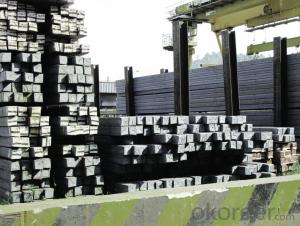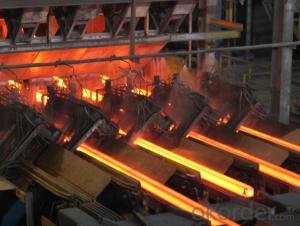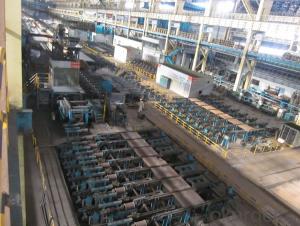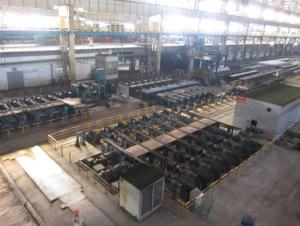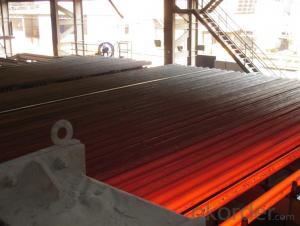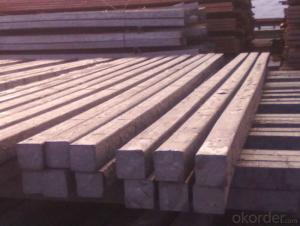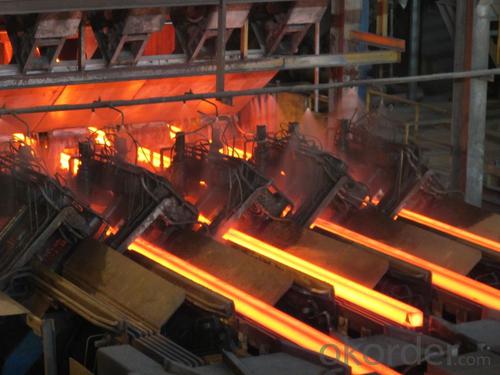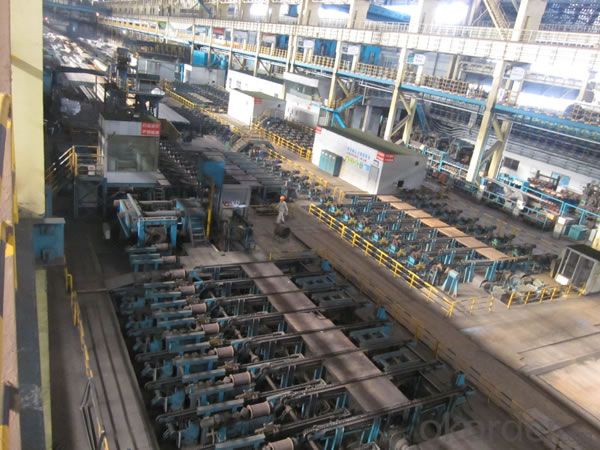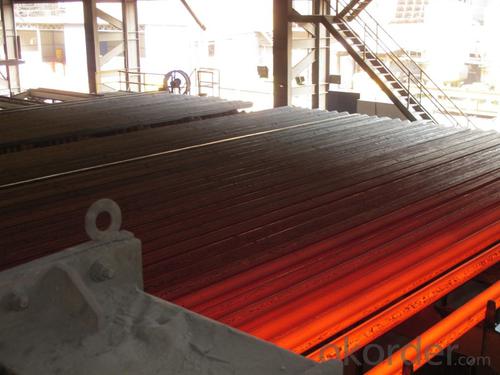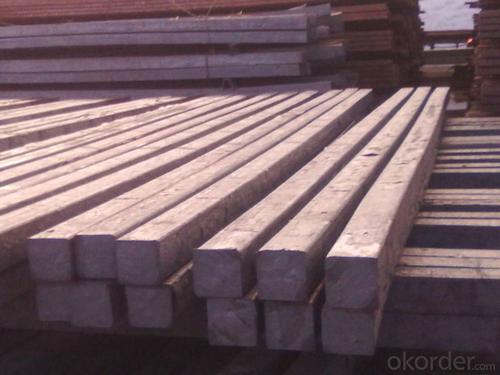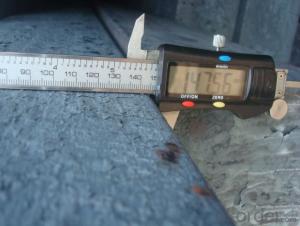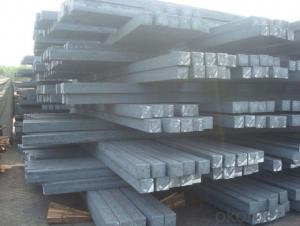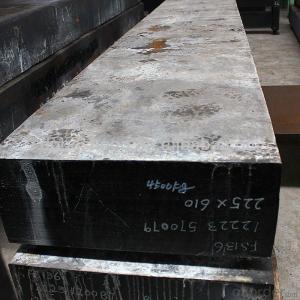Hot Rolled Steel Billet 3SP Standard 120mm
- Loading Port:
- Shanghai
- Payment Terms:
- TT OR LC
- Min Order Qty:
- 100 m.t.
- Supply Capability:
- 10000 m.t./month
OKorder Service Pledge
OKorder Financial Service
You Might Also Like
Structure of Hot Rolled Steel Billet 3SP Standard 120mm
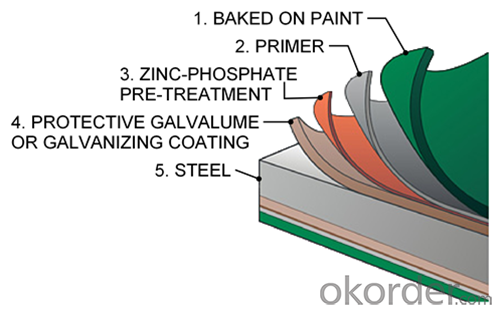
Description of Hot Rolled Steel Billet 3SP Standard 120mm
Prepainted Rolled steel Coil is a kind of coated steel coil/sheet. With the cold rolled steel of different strength and thickness as substrate, it is produced through applying Al-Zn coat on both faces by hot dip process. In its coating, Al accounts for about 55%, Si 1.6%, while the remaining is Zn. Aluminum zinc coils enjoys both the physical protective feature and durability of Al and the electrochemical protective property of Zn. And its surface has bright silver color and regular embossed-like figure, which are highly decorative. RAL Scale Z35 Prepainted Rolled Steel Coil for Construction Roofing
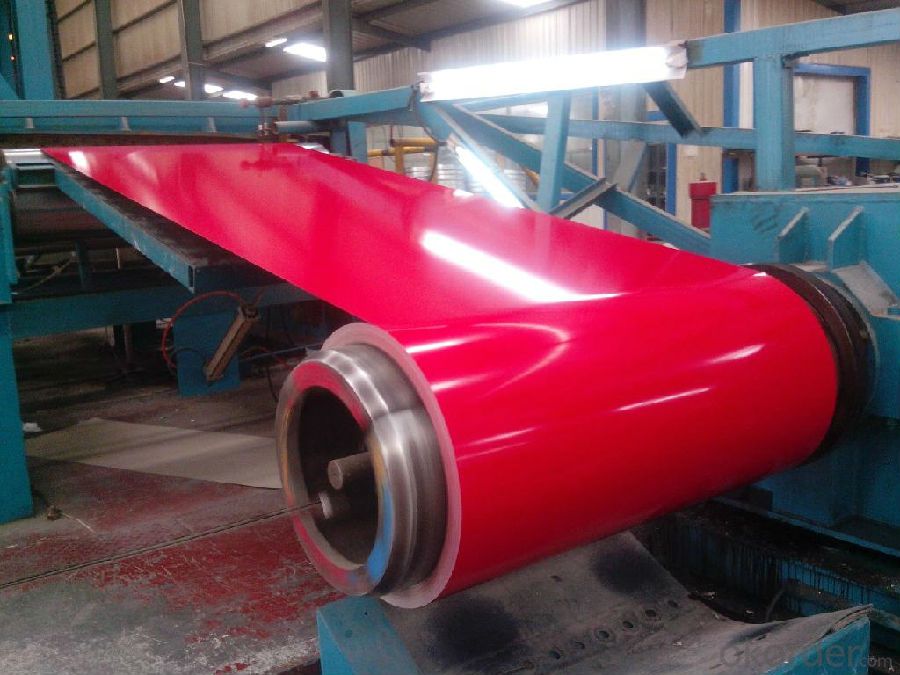
Main Feature of Hot Rolled Steel Billet 3SP Standard 120mm
1.Corrosion resistance: It mainly depends on the zinc protection. When the zinc being worn,
2. Heat resistance: steel sheet has excellent heat resistance, can withstand high temperatures over 300 centigrade, and is similar with aluminized steel high temperature oxidation resistance. It often used in chimney pipes, ovens, fluorescent lighting device and the device cover.
3. Heat reflective: Galvanized steel plate heat-reflective high rate is twice as galvanized steel, often used to make insulation materials. RAL Scale Z35 Prepainted Rolled Steel Coil for Construction Roofing
Applications of Hot Rolled Steel Billet 3SP Standard 120mm
1. Construction and building: roofing; ventilating duct; handrail; partition panel;etc.
2. Electric appliance: refrigerator; washing machine; refrigerator; DVD;etc.
3.Transportation: oil tank; gas tank;road sign; etc.
4.Agriculture constructions :barn; etc.RAL Scale Z35 Prepainted Rolled Steel Coil for Construction Roofing
5.Others:vending machine; game machine; auto parts spare parts etc.
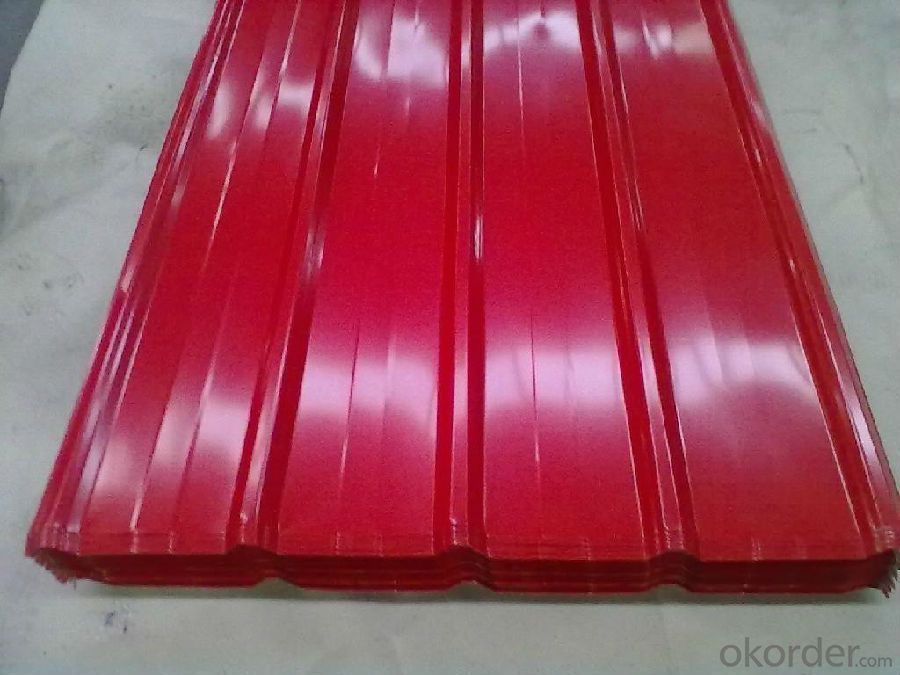
Specifications of Hot Rolled Steel Billet 3SP Standard 120mm
Product | Hot Rolled Steel Billet 3SP Standard 120mm |
Material Grade | SGCC / SGCH / DX51D+AZ, etc |
Thickness | 0.5-3.0mm |
Width | 700-1500mm |
Tolerance | Thickness: +/-0.02mm , Width:+/-2mm |
Zinc-coating | AZ30-150g/m2 |
Technique | Raw material: Hot rolled steel coil --> Cold rolled_>hot dipped galvalume |
Surface | Dried, Chromated, Unoiled,RAL Scale Z35 Prepainted Rolled Steel Coil for Construction Roofing |
Spangle | Regular spangle , small spangle, zero spangle |
ID | 508MM 610MM |
Coil weight | 25MT max |
Export package | Cardboard inner sleeves, Waterproof paper, galvanized steel covered and steel strip packed |
FAQ of Hot Rolled Steel Billet 3SP Standard 120mm
We have organized several common questions for our clients,may help you sincerely:
1. What is the minimum order quantity ?
Our MOQ is 100 mt for each size each specification. Usually we can offer discount if can buy large QTY once. RAL Scale Z35 Prepainted Rolled Steel Coil for Construction Roofing
2. How long can we receive the product after ordering?
Our general delivery time is 30 days after confirmation, but so some special orders, we have offer special delivery time
3. How to guarantee the quality of the products?
We have established the international advanced quality management system ,every link from raw material to final product we have strict quality test;We resolutely put an end to unqualified products flowing into the market. At the same time, we will provide necessary follow-up service assurance.
4. What is the payment?
We accept T/T, L/C
- Q: What are the different methods of steel billet cooling?
- The steel industry commonly employs various methods for cooling steel billets. These methods encompass air cooling, water cooling, and controlled cooling processes. Air cooling serves as one technique to cool steel billets. It entails allowing the billets to cool naturally in the surrounding air, without any additional cooling mechanisms. This method is straightforward and cost-effective, although it may result in slower cooling rates and less control over the cooling conditions compared to other methods. Water cooling represents another prevalent method for cooling steel billets. It involves immersing the billets in water or showering them with water to expedite the cooling process. Water cooling provides more efficient and controlled cooling rates compared to air cooling. It facilitates faster cooling and aids in achieving desired material properties, such as heightened hardness or improved microstructure. Controlled cooling processes constitute a more advanced approach to cooling steel billets. These processes involve meticulous control over temperature and cooling rates to attain specific material properties. One such process, known as quenching, encompasses rapidly cooling the billets in a controlled medium, such as oil or water, to achieve the desired hardness. Another controlled cooling process is referred to as annealing, which involves gradually cooling the billets to relieve internal stresses and enhance their machinability. Furthermore, specialized cooling techniques, such as spray cooling and water mist cooling, find application in specific industries or situations. These methods entail spraying a fine mist of water onto the billets to achieve rapid and uniform cooling. Overall, the selection of a cooling method hinges on several factors, including desired material properties, production requirements, and cost considerations. Different cooling methods offer distinct advantages and compromises, necessitating steel manufacturers to choose the most suitable approach for their specific needs.
- Q: What are the main factors affecting the fatigue strength of steel billets?
- The fatigue strength of steel billets can be influenced by several key factors. 1. Material Composition: The fatigue strength of a steel billet depends on its composition, including the type and quantity of alloying elements present. Elements like carbon, manganese, and silicon have an impact on the billet's ability to resist fatigue and endure cyclic loading. 2. Surface Quality: The fatigue strength of steel billets is closely tied to their surface quality. Surface defects, such as cracks, scratches, or pits, can act as stress concentrators, leading to premature fatigue failure. Therefore, it is imperative to properly prepare and inspect the surface to ensure high fatigue resistance. 3. Heat Treatment: The fatigue strength of a steel billet can be significantly influenced by the heat treatment process used to modify its microstructure. Employing appropriate heat treatment techniques, like quenching and tempering, can enhance the billet's fatigue resistance by improving its hardness, strength, and toughness. 4. Grain Size: The fatigue strength of a steel billet is also affected by the grain size of its microstructure. Finer grains generally exhibit greater fatigue resistance due to reduced stress concentration and enhanced grain boundary strength. 5. Residual Stress: Residual stresses, which can arise from various manufacturing processes, play a crucial role in determining the fatigue strength of steel billets. Excessive residual stress can serve as a starting point for fatigue cracks, thereby diminishing the billet's fatigue life. 6. Operating Conditions: The fatigue strength of steel billets can be influenced by the conditions under which they operate. Factors such as the magnitude and frequency of applied cyclic loads, as well as the temperature, can all have a detrimental impact on the billet's fatigue life. 7. Environmental Factors: The environment in which a steel billet operates can also affect its fatigue strength. Variables like humidity, corrosive gases, and exposure to chemicals can accelerate the initiation and propagation of fatigue cracks, resulting in reduced fatigue resistance. Taking into account and comprehending these primary factors that impact the fatigue strength of steel billets is crucial when designing components and structures that can endure cyclic loading and ensure long-term reliability.
- Q: What are the different production methods for steel billets?
- There are several different production methods for steel billets, each with its own unique characteristics and advantages. 1. Casting: One of the most common methods is the casting process, where molten steel is poured into a mold and allowed to solidify. This method can be further divided into continuous casting and ingot casting. Continuous casting involves the continuous pouring of molten steel into a water-cooled mold, which results in a continuous solidification process. Ingot casting, on the other hand, involves pouring molten steel into individual molds to create ingots that are then used as raw material for further processing. 2. Direct Reduction: Another method is the direct reduction process, which involves the reduction of iron ore in the presence of a reducing agent such as natural gas or coal. This process produces direct reduced iron (DRI), which can then be used to produce steel billets through subsequent melting and casting processes. 3. Electric Arc Furnace (EAF): The EAF method involves melting scrap steel in an electric arc furnace. This process is commonly used in recycling steel as it allows for the use of various scrap sources, including old cars, appliances, and industrial waste. The molten steel is then cast into billets or other desired shapes. 4. Basic Oxygen Furnace (BOF): The BOF method is a traditional steelmaking process that involves the conversion of molten iron from a blast furnace into steel through the injection of oxygen. This process is used for large-scale production of steel billets and offers high efficiency and flexibility in terms of raw material usage. 5. Powder Metallurgy: Powder metallurgy is an alternative method that involves compacting and sintering metal powders to create solid objects. In the case of steel billets, metal powders are compressed into the desired shape and then heated to a high temperature to achieve solidification. Each of these production methods has its own advantages and is suited for different applications and production scales. The choice of method depends on various factors including the desired properties of the steel, cost considerations, environmental impact, and availability of raw materials.
- Q: How are steel billets used in the production of wind turbine components?
- Steel billets are an essential raw material used in the production of wind turbine components. These billets are large, semi-finished blocks of steel that serve as the starting point for various manufacturing processes. One of the primary applications of steel billets in wind turbine production is for the fabrication of tower sections. The tower is a crucial component that supports the entire turbine structure, and it needs to withstand strong winds and other environmental conditions. Steel billets are first heated and then rolled or forged into the desired shape and size to create the tower sections. These sections are then welded together to form the complete tower structure. Additionally, steel billets are also used for manufacturing other wind turbine components such as the hub, nacelle, and main shaft. The hub is the central part of the turbine that holds the rotor blades, while the nacelle houses the generator and other critical components. Both these parts require high-strength steel, which can be obtained by processing steel billets. Similarly, the main shaft, which connects the rotor hub to the gearbox, needs to be extremely durable and able to withstand the torque generated by the blades. The choice of using steel billets in wind turbine production is driven by the material's exceptional mechanical properties. Steel exhibits high strength, allowing the turbine components to withstand the extreme forces they experience during operation. Moreover, steel also possesses excellent fatigue resistance, which is crucial considering the continuous rotation and cyclic loading of wind turbines. Overall, steel billets play a vital role in the production of wind turbine components, ensuring the structural integrity and reliability of these renewable energy systems. By using steel billets, manufacturers can fabricate strong and durable components that contribute to the efficient and sustainable generation of wind power.
- Q: What are the different methods of shaping steel billets?
- There exist various techniques for shaping steel billets, each possessing its own benefits and applications. Common methods include forging, rolling, extrusion, and casting. 1. Forging involves applying pressure through hammers or presses to shape the steel billet. This technique allows for precise shaping, producing complex shapes with high strength and durability. It finds extensive use in manufacturing components for the automotive, aerospace, and construction industries. 2. Rolling entails passing the steel billet through a series of rollers to reduce its thickness and shape it into different forms like sheets, plates, or bars. This method is highly efficient, capable of producing large quantities of steel products with consistent dimensions and surface finish. It is commonly employed in the production of structural steel, pipes, and tubes. 3. Extrusion involves forcing the steel billet through a die to create the desired shape. This technique is particularly suitable for producing long and continuous profiles with complex cross-sections, such as rods, tubes, and wire. It allows for precise control over the shape and dimensions of the final product and is commonly used in manufacturing aluminum window frames, automotive parts, and electrical conductors. 4. Casting entails pouring molten steel into a mold and allowing it to solidify into the desired shape. This process is versatile, capable of producing intricate and large-scale components with minimal material waste. Casting is commonly used in the production of steel ingots, pipes, and large structural components. These various methods of shaping steel billets offer distinct advantages in terms of efficiency, precision, and versatility. The choice of method depends on specific requirements for the desired steel product, including size, shape, strength, and cost-effectiveness.
- Q: How do steel billets contribute to the manufacturing of marine equipment?
- Steel billets are an essential raw material in the manufacturing of marine equipment. They serve as the starting point for various processes such as rolling, forging, and machining, which shape the billets into the desired components. These components, made from high-quality steel, provide strength, durability, and corrosion resistance necessary for marine equipment, ensuring their safe and reliable operation in challenging maritime environments.
- Q: What are the different types of defects in steel billets?
- There are several types of defects that can occur in steel billets, which are essentially semi-finished steel products that are typically used as raw materials for various manufacturing processes. These defects can arise during the production or handling of billets and can affect their mechanical properties, structural integrity, and overall quality. Some common types of defects found in steel billets include: 1. Surface defects: These defects are typically visible on the outer surface of the billet and can include scratches, cracks, pits, or scale. Surface defects can occur due to improper handling, storage, or transportation of the billets, or as a result of poor manufacturing processes. 2. Internal defects: Also known as sub-surface defects, these occur within the cross-section of the billet and are not visible to the naked eye. Internal defects can include blowholes, inclusions, segregations, or voids. These defects can be a result of impurities in the raw materials, improper casting or solidification processes, or inadequate quality control measures. 3. Dimensional defects: These defects refer to deviations in the dimensions of the billet from the specified requirements. This can include variations in length, width, or thickness beyond the acceptable tolerances. Dimensional defects can be caused by factors such as improper cutting, rolling, or cooling processes during billet production. 4. Chemical composition defects: These defects occur when the steel billet does not meet the required chemical composition specifications. This could be due to impurities in the raw materials, improper mixing or alloying processes, or inadequate quality control during the production phase. 5. Mechanical defects: These defects affect the mechanical properties of the steel billet, such as its strength, toughness, or ductility. Mechanical defects can result from improper heat treatment, quenching, or tempering processes, or from inadequate quality control during the manufacturing process. It is important to detect and minimize these defects as they can adversely affect the performance and reliability of the final steel products that are made from these billets. Quality control measures, such as regular inspection and testing, can help identify and rectify any defects in steel billets, ensuring the production of high-quality finished products.
- Q: What are the specifications for steel billets used in the aerospace industry?
- The specifications for steel billets used in the aerospace industry typically include high strength, excellent corrosion resistance, and exceptional mechanical properties to withstand extreme conditions experienced during flight. Additionally, these billets need to meet stringent standards for dimensional accuracy, surface finish, and chemical composition to ensure consistent performance and safety in aerospace applications.
- Q: How are steel billets used in the manufacturing of pumps and compressors?
- Pumps and compressors rely heavily on steel billets, a crucial raw material for their manufacturing process. These semi-finished steel forms are transformed into different components and parts of these devices. To prepare steel billets for shaping, the initial step involves heating them to a high temperature to make them malleable. Once heated, the billets go through various metalworking techniques like forging, rolling, or extrusion. By subjecting them to these processes, the billets are converted into the desired shapes and sizes required for specific pump and compressor components. In pump manufacturing, steel billets are utilized to fabricate impellers, responsible for fluid movement and circulation. The billets are shaped according to the impeller design through machining or casting procedures. Similarly, for compressors, steel billets are used to create vital components like cylinders, pistons, and connecting rods, which facilitate gas compression and movement. The preference for steel billets in pump and compressor manufacturing stems from their advantageous properties, such as strength, durability, and corrosion resistance. These properties are vital for ensuring the efficiency and longevity of these mechanical devices, especially when they operate under high pressures, temperatures, and harsh working conditions. In conclusion, steel billets play a fundamental role in the manufacturing process of pumps and compressors. They provide the necessary raw material for shaping and creating various components that enable these devices to function effectively.
- Q: What are the different types of steel billet casting defects?
- During the casting process of steel billets, various types of defects may occur, impacting the final product's quality and performance. These defects can range in severity and have different effects on the billets. Common defects include: 1. Insufficient feeding of liquid metal during solidification can cause shrinkage defects, resulting in voids or cavities within the billet. This weakens the billet's strength and may lead to failure under stress. 2. Porosity defects are characterized by the presence of small gas bubbles or voids within the billet. They reduce density, weaken the material, and affect mechanical properties such as tensile strength and ductility. 3. Foreign substances, such as non-metallic particles, oxides, or impurities, can become trapped within the billet, resulting in inclusion defects. These negatively impact mechanical properties like ductility and increase brittleness. 4. Surface defects, like cracks, scabs, or uneven surfaces, can occur during casting, affecting the appearance and structural integrity of the billet. 5. Uneven distribution of alloying elements within the billet leads to segregation defects. This inconsistency in composition affects mechanical properties and overall performance. 6. During solidification, thermal stresses can cause cracks known as hot tears, weakening the billet and reducing its strength under stress. 7. When the liquid metal fails to completely fill the mold cavity, misruns occur, resulting in incomplete billets. This defect leads to reduced dimensions, poor surface finish, and compromised mechanical properties. Addressing and identifying these defects is crucial to ensure the production of high-quality and reliable steel products. Techniques such as proper mold design, controlling casting parameters, and process optimization can be employed to minimize these defects and improve the overall quality of the billet.
Send your message to us
Hot Rolled Steel Billet 3SP Standard 120mm
- Loading Port:
- Shanghai
- Payment Terms:
- TT OR LC
- Min Order Qty:
- 100 m.t.
- Supply Capability:
- 10000 m.t./month
OKorder Service Pledge
OKorder Financial Service
Similar products
Hot products
Hot Searches
Related keywords
